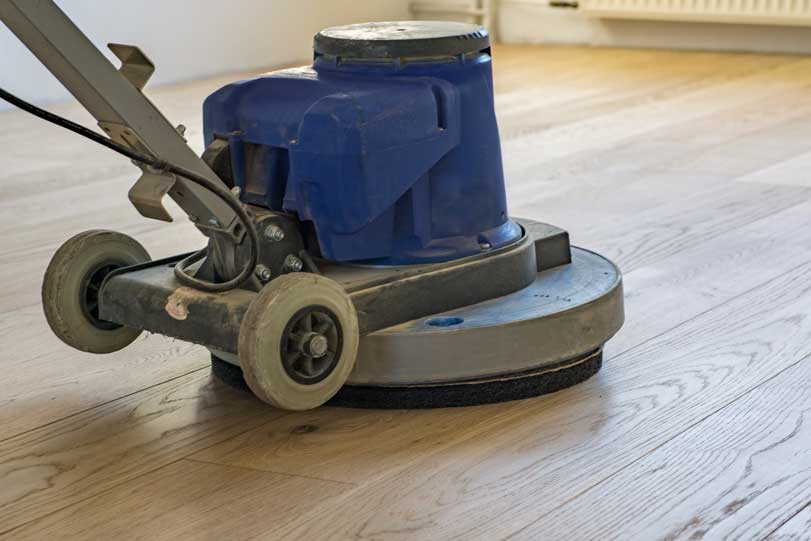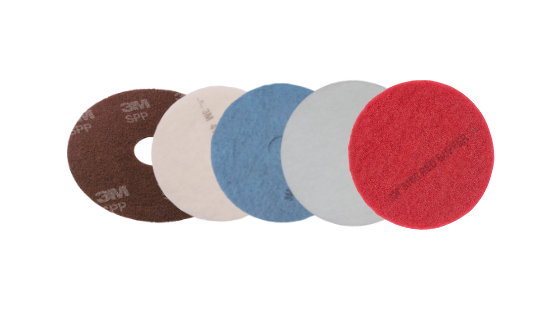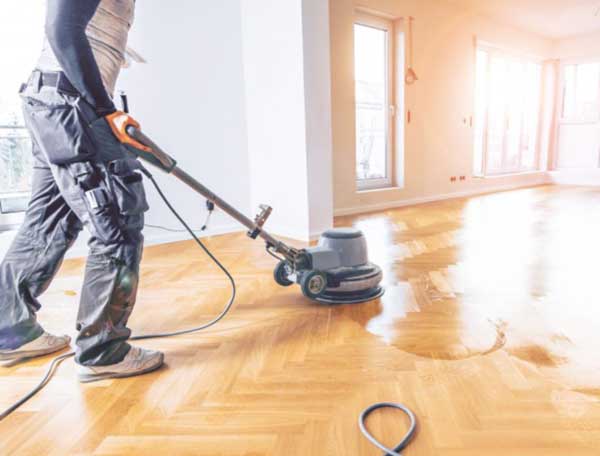Buffing vs Sanding Your Hardwood Floors – Avoid Common Mistakes
Is the finish on your hardwood floors in rough shape? Dull and scratched? Thinking of sanding your hardwood floor? You may be able to simply buff or screen your floors to bring back their luster. Learn when you should buff, or sand, and how to avoid common mistakes.
If your floors require revitalization, you might wonder about the best method to have them look as new again. With so many methods to brighten up your hardwood floors, it can be confusing to choose which one is best.
My floors had this problem. I had light scratches from the dog and other traffic, but the finish was still in tact. So, after doing some research I learned you can just buff the floors and apply a light coat of finish over the top. This way it’s much faster, easier, and it can brighten up the floors beautifully. So, I want to share the information I found.
What is the difference between sanding and refinishing, or buffing?
Two of the common and effective ways to rejuvenate your floors are through buffing and sanding them. You might think that these are interchangeable terms and methods, but they are definitely not. They both have different processes and benefits, which is why it’s important to know which one to do.
Sometimes folks will think they need to sand all the way down to bare wood, when all they need is to buff them out. Other times, people try to buff them out and it does nothing to repair the damaged areas.
Which one is the better method, though?

Sanding Your Floors
When sanding hardwood floors, you will use large sanding equipment, which will remove all the finish and stains from the floors. This also levels the floor, and smooths out the wood once the finish is removed.
Sanding is an intensive process which would strip everything from the floors by grinding it down until it reaches the natural wood. After the equipment has removed the protective layers of sealers, you’ll continue sanding the hardwood. It removes scratches, dents, and other imperfections. One would usually do this using a drum floor sander, and other heavy equipment that is typically not for the DIY homeowner.

This process requires sanding the floor entirely a few times throughout, using progressively fine sandpaper. This will ensure that the floor is as smooth as possible before you refinish it. After you have done the sanding process, the floor is generally stained again, and once the stain has dried, you’ll finish it off using lacquer, polyurethane wood finish, or an alternative oil or sealer.
Buffing or Screening
Recoating hardwood floors has a couple of different names that all mean the same procedure – “screen and recoat” and “buff and coat”.

Basically it is taking a buffer and a mesh sanding screen, or abrasive pad, and scuffing the existing floor finish so a new top coat of finish will adhere to it. There is also a similar process done with chemicals that etches the surface layer so the new coating will adhere to the old one. I have seen this process before, and the finished product isn’t as impressive as using abrasives.
Buffing wood floors gets rid of minor scratches or scuffs to give the floor an attractive and shiny luster that can last for years. Although buffing might look simple and affordable, it consumes a lot of time. When quality buff and coat is applied to a hardwood floor, it yields an attractive look.
What Is Screening Hardwood Floors?
Screening is a process that takes off the top layer of polyurethane but doesn’t remove any wood. Screening is similar to buffing. They mean almost the same thing. They all refer to scuffing up or abrading the floor. Floor buffing & screening is done to prepare the floor before you apply a coat of the finish to protect and shine. It’s a relatively inexpensive technique has less risk and saves you the cleanup and hassle associated with floor sanding.
How Do You Recoat and Screen a Wood Floor?
Screens are clog-resistant sanding disks. Screening is done with a 16-inch floor polisher, which works like a giant oscillating sander. It won’t take off on you like a drum sander and doesn’t require a lot of strength. The weight of the floor polisher and a synthetic-wool pad hold the screen in place.
When Should a Buff and Coat Be Done?
Buffing or screening your floors will make your floors look brilliant again, if they have light scratches or a dull finish. My floors had wear in traffic areas, and buffing was able to make them shine again. But don’t wait too long.
A lot of people think it can be done once the finish has started to wear through.
Unfortunately, if your floors get to this stage then they’re already past being a candidate for screening and recoating. This procedure needs to be done before the finish has become too thin or worn through and you can see wear and damage.

The floor pictured to the right is damaged beyond buffing or screening and would need to be sanded.
Keep an eye on the high traffic areas in your home. Kitchens, entrances, hallways, areas where the dogs run and high traffic flow areas around furniture.
Once you start seeing signs of wear and tear in these areas, start thinking about adding another coat of finish for more protection. A general time frame is every 3-5 years or so, depending on how much traffic your floor sees.
Once there is damage, or the finish is worn through, it’s too late. However, the good news is if it’s just worn and dull, or has light scratching, you can still brighten your finish without having to sand it all the way down.
Are All Hardwood Floors Able to be Buffed and Coated?
Not all floors can be buffed, and you’ll have to take a close look before starting. Many floors have far too much damage to qualify to have a screen and recoat.
If your hardwood floor has deep scratches, pet urine stains, water damage, discoloration, or layers of caked on floor polish (especially with wax) then no matter how much buffing you do, and how much new finish you put on, you will still have poor looking, damaged areas showing through.
Other things to consider – Don’t make these mistakes:
- Only screen a polyurethane finish, a non-penetrating plastic coating that sits on top of the floor.
- Only screen when the finish is worn, scratched or dull but the wood beneath is not stained or damaged.
- You can’t screen a polyurethane floor that has been waxed or has a build-up of a cleaning product
Recently there has been an influx of businesses and franchises that make huge promises and claims about being able to bring your floors back to life cheaply and without the dust and mess of traditional hardwood floor refinishing. My neighbor had their floors mopped with chemicals to abrate the floors prior to being re-coated. It looked horrible, and had to be sanded down to bare wood to fix it.
So be careful if a company promises fast, easy results in a day that will be “as good as” the traditional process of hardwood floor sanding and refinishing.
How much Does Screening Cost?
If you want to do it yourself, renting the machine costs around $25-$60 per day. The 60- to 120-grit disks used with this unit cost $6 to $10 each. But, if you’re not really handy I would advise you hire a professional floor refinisher. This will cost $1.50-$3 per square foot, depending on how much screening needs to be done and whether the floor needs one or two coats of finish.
Conclusion
So if you have hardwood floors that aren’t super damaged, the ‘screen and recoat’ or ‘buff and coat’ procedure could be perfect for you to help extend the life of your floors.
Otherwise, if you have dents, deep scratches, pet urine stains, water damage, build-up of waxy cleaning products causing contamination issues, UV discoloration , then your only options is a traditional sand and refinish job.
Overall, it’s important to consider the buff or screen and recoat process. If you do this before the floors are too far gone it will save you a ton of money and maintain a brilliant look on your floors. It can also save you a ton of money and trouble.



